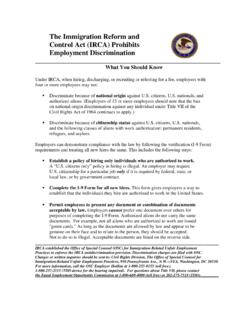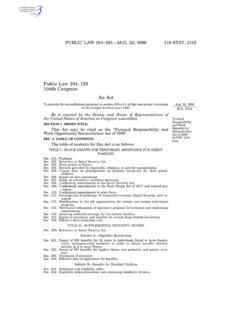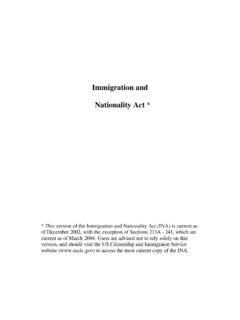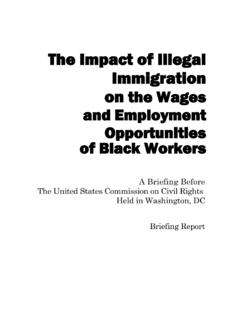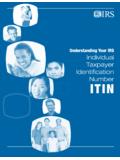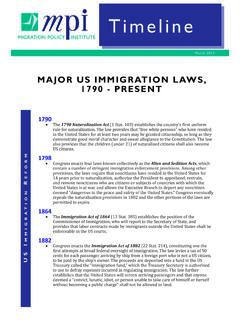Transcription of The Trump Administration’s “Zero Tolerance” Immigration ...
1 The Trump Administration s Zero Tolerance Immigration Enforcement Policy Updated February 2, 2021 Congressional Research Service R45266 The Trump Administration s Zero Tolerance Immigration Enforcement Policy Congressional Research Service Summary For the last decade, Central American migrant families have arrived at the border in relatively large numbers, many seeking asylum. While some request asylum at ports of entry, others do so after entering the United States without inspection ( , illegally) between ports of entry. On May 7, 2018, the Department of Justice (DOJ) implemented a zero tolerance policy toward illegal border crossing both to discourage illegal migration into the United States and to reduce the burden of processing asylum claims that Trump Administration officials contended are often fraudulent. Under the zero tolerance policy, DOJ prosecuted all adult aliens apprehended crossing the border illegally, with no exception for asylum seekers or those with minor children.
2 DOJ s policy represented a change in the enforcement of an existing statute rather than a change in statute or regulation. Prior administrations had prosecuted illegal border crossings relatively infrequently. Data are not available on the rate and/or absolute number of family separations resulting from illegal border crossing prosecutions under prior administrations, limiting the degree to which comparisons can be made with the Trump Administration s zero tolerance policy Criminally prosecuting adults for illegal border crossing requires detaining them in federal criminal facilities where children are not permitted. While DOJ and the Department of Homeland Security (DHS) have broad statutory authority to detain adult aliens, children must be detained according to guidelines established in the Flores Settlement Agreement (FSA), the Homeland Security Act of 2002, and the Trafficking Victims Protection Reauthorization Act of 2008.
3 A 2015 judicial ruling held that children can remain in family Immigration detention for no more than 20 days. If parents cannot be released with them, children must be treated as unaccompanied alien children and transferred to the Department of Health and Human Services (HHS s) Office of Refugee Resettlement (ORR) for care and custody. The widely publicized family separations were a consequence of the Trump Administration s zero tolerance policy, not the result of an explicit family separation policy. Following mostly critical public reaction, President Trump issued an executive order on June 20, 2018, mandating that DHS maintain custody of alien families during the pendency of any criminal trial or Immigration proceedings. DHS Customs and Border Protection (CBP) subsequently stopped referring most illegal border crossers to DOJ for criminal prosecution. A federal judge then mandated that all separated children be promptly reunited with their families.
4 Another rejected DOJ s request to modify the FSA to extend the 20-day child detention guideline. DHS has since reverted to some prior Immigration enforcement policies, and family separations continue to occur based upon DHS enforcement protocols in place prior to the 2018 zero tolerance policy. On January 26, 2021, during the first month of the Biden Administration, the Department of Justice formally rescinded the zero tolerance policy. During the six weeks the policy was active, DHS separated 2,816 children subsequently included in a class action lawsuit from their parents or guardians. Almost all have since been reunited with their parents or placed in alternative custodial arrangements. In 2019, DOJ disclosed the separations of an additional 1,556 children prior to the zero tolerance policy but also during the Trump Administration who were included in the lawsuit class.
5 As of December 2020, a steering committee assembled to locate separated children in this second group had not yet established contact with the parents of 628 children. In the period since the zero tolerance policy was effectively paused in June 2018, at least 1,000 additional children were separated, bringing the total reported number of separated children to between 5,300 and 5,500. The Trump Administration s Zero Tolerance Immigration Enforcement Policy Congressional Research Service Trump Administration officials and Immigration enforcement advocates argued that measures like the zero tolerance policy were necessary to discourage migrants from coming to the United States and submitting fraudulent asylum requests. They maintained that alien family separation resulting from the prosecution of illegal border crossers mirrored that which occurs regularly under the criminal justice system policy where adults with custody of minor children are charged with a crime and may be held in jail, effectively separating them from their children.
6 Immigrant advocates contended that migrant families were fleeing legitimate threats from countries with exceptionally high rates of gang violence, and that family separations resulting from the zero tolerance policy were cruel, unconstitutional, and violated international human rights law. They maintained that the zero tolerance policy was hastily implemented and lacked planning for family reunification following criminal prosecutions. Some observers questioned the Trump Administration s capacity to marshal sufficient resources to prosecute all illegal border crossers without additional resources. Others criticized the family separation policy in light of less expensive alternatives to detention. Family separation-related legislation introduced during the 116th and 115th Congresses focused primarily on preventing or limiting the practice. Few of the bills saw congressional action.
7 The Trump Administration s Zero Tolerance Immigration Enforcement Policy Congressional Research Service Contents Introduction .. 1 Enforcement and Asylum Policy for illegal Border Crossers .. 3 illegal 3 Asylum .. 4 Detention .. 5 Removal .. 6 Prosecution of Aliens Charged with illegal Border Crossing in Prior Administrations .. 6 Prosecution of Aliens Charged with illegal Border Crossing during the Trump Administration .. 8 Timeline on Family Separation .. 9 9 10 15 18 19 Policy 20 Enforcement Perspectives .. 20 Immigrant Advocacy 22 Congressional Activity .. 25 116th Congress .. 25 115th Congress .. 26 Contacts Author Information .. 26 The Trump Administration s Zero Tolerance Immigration Enforcement Policy Congressional Research Service 1 The Zero Tolerance Policy Under the Biden Administration This report is a historical document about the zero tolerance Immigration enforcement policy and the resulting practice of separating children from parents and legal guardians under the Trump Administration.
8 On January 26, 2021, Acting Attorney General Monty Wilkinson, during the first month of the Biden Administration, issued a DOJ memorandum formally rescinding the zero tolerance This report will not be updated. Introduction In recent years, Central American migrant families have been arriving at the border in relatively large numbers, many seeking While some request asylum at ports of entry, others do so after attempting to enter the United States illegally between ports of On May 7, 2018, then-Attorney General Jeff Sessions announced that the Department of Justice (DOJ) implemented a zero tolerance policy toward illegal border crossing, both to discourage illegal migration into the United States and to reduce the burden of processing asylum claims that Trump Administration officials contended are often Under the zero tolerance policy, DOJ prosecuted 100% of adult aliens5 apprehended crossing the border illegally, making no exceptions for whether they were asylum seekers or accompanied by minor children.
9 illegal border crossing is a misdemeanor6 for a first time offender and a felony7 for anyone who has previously been denied admission, excluded, deported, or removed, or has departed the United States while an order of exclusion, deportation or removal is outstanding and 1 Depart ment of Just ice, Office of t he At t orney General, Mem orandum for all Federal Prosecutors, Rescinding t he Zero-Tolerance Policy for Offenses Under 8 1325(a), January 26, 2021. 2 Asylum is a prot ect ion grant ed t o a foreign nat ional physically present wit hin t he Unit ed St at es or at t he border who meet s t he definit ion of a refugee. A refugee is a person who is out side his or her home count ry (a second count ry t hat is not t he Unit ed St at es) and is unable or unwilling t o ret urn because of persecut ion, or a well-founded fear of persecut ion, on account of five possible crit eria: (1) race, (2) religion, (3) nat ionalit y, (4) membership in a part icular social group, or (5) polit ical opinion.
10 INA 1101(a)(42)(A). In recent years, part icularly following t he surge of unaccompanied children at t he Sout hwest border in 2014, court s have grappled wit h whet her t he st at ut ory definit ion of asylum can encompass t hreat s like gang violence. In some cases, asylum has been grant ed on such grounds. For more informat ion, see CRS Report R45539, Im m igration: Asylum Policy. 3 A port of ent ry is a harbor, border t own, or airport t hrough which people and goods may ent er a count ry. T he Unit ed St at es current ly has 328 port s of ent ry. For background informat ion relat ed t o ports of ent ry and border securit y, see CRS Report R43356, Border Security: Im m igration Inspections at Ports of Entry; and CRS Report R42138, Border Security: Im m igration Enforcem ent Between Ports of Entry. 4 Department of Justice, Office of Public Affairs, Attorney General Sessions Delivers Remarks Discussing the Immigration Enforcement Actions of the Trump Administration, May 7, 2018.










